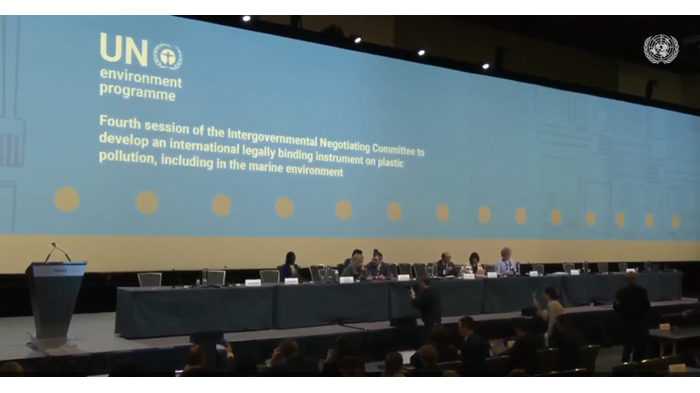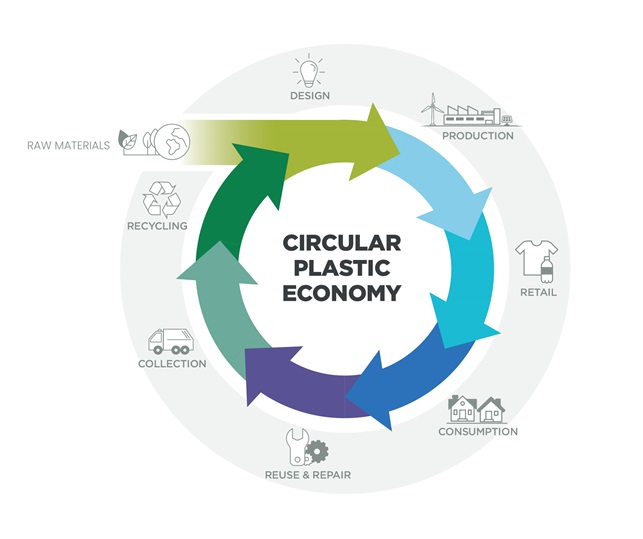Message in a bottle: How the Global Plastic Treaty is making the case for optimism and the end of plastic waste
On the empty end, it’s easy to see why, particularly for young people, there can be a feeling of hopelessness and frustration about our environment’s future. Every day, there’s more emotionally jarring news, like the sight of the Great Pacific Garbage Patch or the discovery that microplastics are present in human blood samples. While companies signed on to Ellen MacArthur Foundation’s New Plastics Economy Global Commitment have made progress, the world remains significantly off track when it comes to meeting its targets. When you factor in that negative news spreads quickly on social media and our brains tend to dwell on bad news, it's understandable why many find the prospect of such a bleak future anxiety-inducing.
To keep pressing forward, we need to know that there is a plan for transformative change and that there are clear actions and measures that can be achieved.
That’s where the Global Plastics Treaty comes in. In a historic move, 175 nations agreed to develop a legally binding agreement on plastic pollution by 2024, prompting a major step towards reducing greenhouse gas emissions from plastic production, use and disposal. Once developed and agreed upon, it will serve as a blueprint for the future, improving plastic circularity on a scale that wouldn't be achievable without a united effort from governments and international organizations.
Moreover, the treaty creates a clear sense of what's possible and that the door has been opened for a few important things to happen.
A debate to overcome challenges and take advantage of opportunities
At the highest level, the treaty aims to cover everything about plastic - from when and how it's made to how it's reused, recycled and ultimately disposed of when it’s no longer useful. Nations are aiming to hammer out a draft of the treaty by the end of the year, at the final round of negotiations in South Korea. Negotiators have a tough task, with the multitude of stakeholders divided over how ambitious the treaty should be.
For example, countries are keen on creating a solid plan to tackle plastic pollution, but there's much disagreement on what it should include. Some want each country to lead its own efforts, like in the Paris Agreement where countries set their own goals and report on progress. Others think we should veer from that model towards establishing strong common measures that are mandated versus more voluntary options. Additionally, scientists are also urging negotiators to toughen rules against making harmful and unsustainable plastics and chemicals, and to mandate testing for chemicals used in making plastics.
However, while the ongoing negotiations presents challenges, there are also some encouraging signs that this treaty will not only address the root causes of the plastic waste crisis but do so in a holistic way.
A key development on this front is that member states are embracing reimagining the role of stakeholders and the concept of a multi-stakeholder action plan. More than 200 global businesses and financial institutions back the treaty, understanding the advantages of global regulations for both business and the environment. Tackling plastic waste is complicated and involves many players, so it's crucial for stakeholders to collaborate and take action at different levels. Having stakeholder engagement in the treaty speeds up commitments from industry, bridging the gap between global scientific findings and the treaty's implementation.

Another major opportunity that the treaty is taking up is fundamentally rethinking how resources are consumed and used through a product’s lifecycle. That’s important because this perspective encourages stakeholders to view the treaty not only as a solution to plastic pollution but also as a way to transition to more circular economy practices. Key elements like supporting container reuse and refill options, mandating more post-consumer content into new packaging and designing products for circularity are essential for making this shift happen in practice.
Supporting that approach is the call for developing and agreeing on design requirements, often referred to as harmonized standards. Industry stakeholders are one of the key factions driving this outcome, as it will provide much-needed clarity on what needs to be done and level the playing field so actions can be scaled. This process does not in any way preclude initiatives that are currently happening to address the plastic pollution problem. Meaningful actions by businesses, such as SC Johnson’s efforts to redesign packaging and drive product refill and reuse options to reduce plastic waste, decrease new plastic production and keep plastic already made in use is essential work that needs to continue.

Action that drives change
Will a Global Plastic Treaty be enough to refire hope that change will happen? Plastic Free Foundation found that 88% of people polled believe it’s important to have an international treaty to combat plastic pollution. The unique potential of a global, United Nations-led treaty is to hold all countries to a high common standard on plastic consumption and create a clear path toward a future free from plastic pollution. Perhaps, however, the most significant hopeful sign from a global treaty is that it shows that almost everyone now agrees that we need to take tangible action – and they are ready to do it.
That’s important because the landscape for changing the status quo is complicated. There’s a lot of government gridlock when it comes to passing legislation. There’s public skepticism about whether companies making sustainability commitments are making real progress toward their goals. And more than a few companies are not overly eager to have more government regulation of their businesses.
However, substantial change can happen, even in the most challenging landscape.
For example, when SC Johnson was the first to remove chlorofluorocarbons (CFCs) from all its products because they might harm the ozone layer, many industry executives told the government there was no way to remove them. Not only did fourth-generation leader Sam Johnson do it, but he also took a public stance that helped build support among corporations for broader bans, eventually resulting in the Montreal Protocol – the only global treaty to achieve universal ratification of 197 countries.
That historic achievement was in June of 1975 – 49 years ago. If agreed to and implemented, the Global Plastic Treaty could be the most significant deal since the 2015 Paris Agreement, when nations agreed to keep global temperatures from rising beyond 1.5°C - more than enough to give hope that, ultimately, our half-full bottle of optimism never becomes plastic waste.